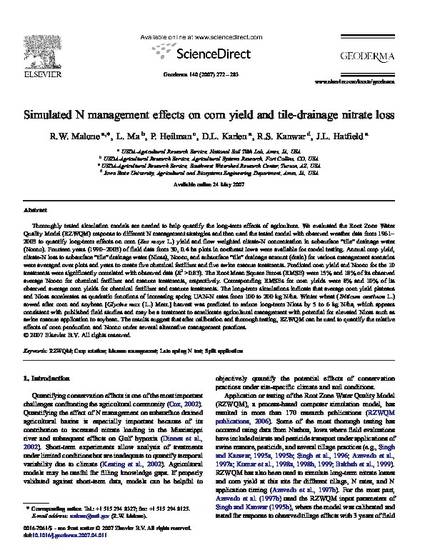
Thoroughly tested simulation models are needed to help quantify the long-term effects of agriculture. We evaluated the Root Zone Water Quality Model (RZWQM) response to different N management strategies and then used the tested model with observed weather data from 1961–2003 to quantify long-term effects on corn (Zea mays L.) yield and flow weighted nitrate-N concentration in subsurface “tile” drainage water (Nconc). Fourteen years (1990–2003) of field data from 30, 0.4 ha plots in northeast Iowa were available for model testing. Annual crop yield, nitrate-N loss to subsurface “tile” drainage water (Nloss), Nconc, and subsurface “tile” drainage amount (drain) for various management scenarios were averaged over plots and years to create five chemical fertilizer and five swine manure treatments. Predicted corn yield and Nconc for the 10 treatments were significantly correlated with observed data (R2 > 0.83). The Root Mean Square Errors (RMSE) were 15% and 18% of its observed average Nconc for chemical fertilizer and manure treatments, respectively. Corresponding RMSEs for corn yields were 8% and 10% of its observed average corn yields for chemical fertilizer and manure treatments. The long-term simulations indicate that average corn yield plateaus and Nloss accelerates as quadratic functions of increasing spring UAN-N rates from 100 to 200 kg N/ha. Winter wheat (Triticum aestivum L.) sowed after corn and soybean [Glycine max (L.) Merr.] harvest was predicted to reduce long-term Nloss by 5 to 6 kg N/ha, which appears consistent with published field studies and may be a treatment to ameliorate agricultural management with potential for elevated Nloss such as swine manure application to soybean. The results suggest that after calibration and thorough testing, RZWQM can be used to quantify the relative effects of corn production and Nconc under several alternative management practices.
Available at: http://works.bepress.com/rskanwar/14/

This article is from Geoderma 140 (2007): 272–283, doi:10.1016/j.geoderma.2007.04.011.